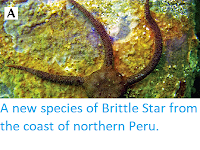The Ophiocistioids are an extinct group of Echinoderms related to Sea Urchins and Sea Cucumbers. They had a flattened dome-shaped body with a five-jawed mouth on the underside, and a surrounding ring of ambulacra (limbs like those of a Starfish). The Ophiocistioids are generally thought to have become extinct at the end of the Permian, with their body fossils always having been rare. However their unique jaw apparatuses can be used to identify members of this group to species level, raising the possibility that this group could be identified more widely in the fossil record.
In a paper published in the journal Palaeontology on 27 July 2018, Mike Reich of the Bavarian State Collection of Palaeontology & Geology, the Department of Earth & Environmental Sciences and the GeoBio-Center at Ludwig-Maximilians-Universität München, Tanja Stegemann, also of the Department of Earth & Environmental Sciences at Ludwig-Maximilians-Universität München, and of the Geoscience Museum at Georg-August University Göttingen, Imaelda Hausmann, again of the Bavarian State Collection of Palaeontology & Geology, and the Department of Earth & Environmental Sciences at Ludwig-Maximilians-Universität München, Venessa Roden of the GeoZentrum Nordbayern at the Universität Erlangen-Nürnberg, and Alexander Nützel, once again of the Bavarian State Collection of Palaeontology & Geology, the Department
of Earth & Environmental Sciences and the GeoBio-Center at
Ludwig-Maximilians-Universität München, describe the first known post-Permian Ophiocistioid, from the Late Triassic Cassian Formation of the South Tyrol Province of northern Italy.
The Cassian Formation comprises marine grey and brown claystones laid down between the carbonate platforms that make up the Dolomites. These sediments are soft, and easily eroded where they outcrop, leading to frequent landslips. The specimen from which the new Ophiocistioid comes from such a landslip exposure, from a sample collected near Misurina and sieved for small fossils, which produced a yield dominated by Gastropods, with smaller numbers of Bivalves, Scaphopods and Ammonites, as well as a variety of disarticulated Echinoderm fragments.
The new Ophiocistioid is placed in the genus Linguaserra, and given the specific name triassica, in reference to the age of the strata that produced it. The species is described from a single goniodont (jaw element), comprising a single primary denticle, 484 μm in length with eleven secondary denticles.
Linguaserra triassica, goniodont. (A), (C) outer (abaxial face). (B) inner view (adaxial face). Light microscopic images (A), (B) and SEM image (C). Specimen from the early Carnian Cassian Formation near Misurina (46°35041.6″ N, 12°15034.6″ E), South Tyrol, Italy. Scale bar represents 0.1 mm. Reich et al. (2018).
See also...
Follow Sciency Thoughts on Facebook.







